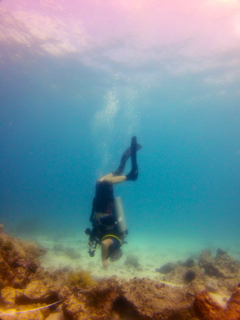What does LIT mean to you?
LIT.
What does that mean to you? To me its a Line Intercept Transect. A kind of survey we conduct on various sights here in the Seychelles. Finally after 4 weeks I’ve graduated from coral spots, having proved I can now identify 52 different coral genii under water, to LIT Methodology (the step before actually conducting research) to (queue emotive music) LIT surveys!
Our base here at Cap Ternay (look it up on google maps!) is a Marine Park. One of three here on Mahe island. As a coral kid the data I collect will be send to Marine Conservation Society Seychelles (MCSS).
LIT surveys are tough. You are vertical the whole time, your head in the coral, swaying in the surge. The science coordinator here, Lee, a smart English all round handy man, says LITs provide so much information and data on the reef, which only fuels my enthusiasm.
We’re on the boat. We arrive at the site, Ray’s Point, and I slip my weight belt on and clamber into my BCD. Last one on does the buddy check. BCD- inflate and deflate your BCD and check your shoulder and kidney dumps. Orally inflate for the roll. Releases and weights, tell your dive buddy what weights you are wearing, where they are and your releases. 6 lbs, right hand release, black right and tight, standard releases. Air. Take your regulator and take three sharp breaths, looking at your gauge to ensure your air is flowing consistently. Do the same with your occy (spare regulator). And now do your final ok, have you got everything. For a survey you need a tape, a slate, a million pencils and a smile.
Once ready, the captain will give specific instructions determining where to survey- deep right, shallow left which determines where you lay the tape with respect to a uniform centre point and the depths at which the survey can be conducted. Today I’ve got a deep left- between 6.6 and 16 metres.
Masks on, regulator in, on roll, roll. Splash, you’re in the water paddling with your LIT buddy, a volunteer trained in spotting invertebrates to give a holistic idea of the health of the reef. Once you’re at the right spot on the reef you descend. Reg in, ok? ok. Deflate your BCD and descend to the reef. LITs are random so once you reach the reef you lay the tape, rolling it out over coral, rubble, sand and urchins. Once at 10 metres you measure depth, ensuring its within the margins determined by the captain.
And the fun begins. For the next half and a hour you move along the tape back toward 0 recording with great detail what is under the tape. Coral genus, life form and substrate. 10.00- 9.98 TA-RK (turf algae on rock). 9.98-9.76 ACP-BR-RK (branching Acropora on rock). And so forth. For 10 metres.
Its amazing how much more of my tank I am using for these dives. I was proud of myself. My air consumption had decreased to a healthy 1300PSI, but now I use about 1800PSI. Its because I am concentrating so hard. I have to keep myself as still as possible to see the various life directly under the coral, is that indeed Pavona, Agariciidae or Leptoseris, or is it turf algae of a corallimorph?
But I love it. I love how detailed I get to be, I love how everything is there, and all you have to do is look for it. I love contributing to science.
So after the 10 metres is up, I signal to Josh, a hilarious Canadian marine engineer, finished? Yup. I reel up the tape with two minutes to spare for a swim around. We spot a huge 1 metre long prickly redfish sea cucumber and a huge hiding puffer fish.
(This is Smyphyllia, Mussidae, beautiful isn't it? I took this photo in the marine park, BTC North East)
Its been 45 minutes, time to head back up to the real world. We have a 3 minute safety stop at 5 metres where we hang in the surge, floating at the sea's whim. And all the while my mind is racing through the coral I saw, its state of health and the future of coral here and everywhere.
We surface and clamber onto the boat, and on the ride in I smile. Some days I feel hopeful for the coral I have come to love, and others I feel disturbed and depressed. But today, the coral looked healthy, and the variety was substantial. This spot is healthy, and as we bounce over the waves in our boat, Manta, the sun cuts through the clouds and warms my cheeks.
And that is what LIT means to me.
(This is Acanthastrea, Mussidae. Its really colourful, I love surveying sites that have these, so beautiful!)













0 comments:
Post a Comment